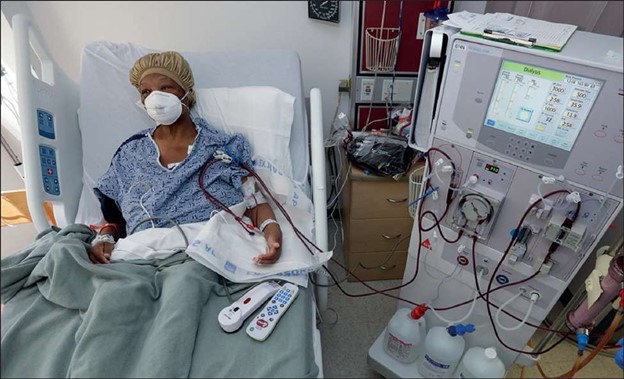The nurse is assessing a patient with acute renal failure.
Which of the following would be a priority nursing intervention?
Administering a potassium-sparing diuretic.
Encouraging the patient to consume a high-sodium diet.
Monitoring urine output and fluid balance.
Administering intravenous antibiotics.
The Correct Answer is C
This is because acute renal failure is a condition where the kidneys lose their ability to filter waste and excess fluid from the blood. This can lead to fluid overload, electrolyte imbalances, and metabolic acidosis. Therefore, the nurse should monitor the patient’s urine output and fluid balance to assess the severity of the renal impairment and prevent complications.
Choice A is wrong because administering a potassium-sparing diuretic would worsen the patient’s hyperkalemia, which is a common complication of acute renal failure.
Choice B is wrong because encouraging the patient to consume a high-sodium diet would increase the patient’s fluid retention and blood pressure, which can further damage the kidneys.
Choice D is wrong because administering intravenous antibiotics is not a priority intervention for acute renal failure unless there is a specific indication of infection.
Nursing Test Bank
Naxlex Comprehensive Predictor Exams
Related Questions
Correct Answer is A
Explanation

This is because hemodialysis removes excess fluid and waste products from the blood, but it also removes some electrolytes, such as potassium.
Potassium is important for nerve and muscle function, especially the heart.
If potassium levels are too high or too low, it can cause irregular heartbeat or cardiac arrest.
Choice B is wrong because hypokalemia means low potassium levels, which is unlikely in renal failure unless there is excessive potassium loss from diarrhea, vomiting or diuretics.
Choice C is wrong because hyponatremia means low sodium levels, which can occur in renal failure due to fluid retention, but it is not directly related to hemodialysis.
Choice D is wrong because hypernatremia means high sodium levels, which can occur in renal failure due to reduced urine output, but it is also not directly related to hemodialysis.
Normal ranges for electrolytes are: Potassium: 3.5 to 5.0 mmol/L
Sodium: 135 to 145 mmol/L
Calcium: 8.5 to 10.5 mg/dL
Chloride: 96 to 106 mmol/L
Magnesium: 1.7 to 2.2 mg/dL
Phosphate: 2.5 to 4.5 mg/dL
Bicarbonate: 22 to 29 mmol/L
Correct Answer is C
Explanation
This is because acute renal failure is a condition where the kidneys lose their ability to filter waste and excess fluid from the blood. This can lead to fluid overload, electrolyte imbalances, and metabolic acidosis. Therefore, the nurse should monitor the patient’s urine output and fluid balance to assess the severity of the renal impairment and prevent complications.
Choice A is wrong because administering a potassium-sparing diuretic would worsen the patient’s hyperkalemia, which is a common complication of acute renal failure.
Choice B is wrong because encouraging the patient to consume a high-sodium diet would increase the patient’s fluid retention and blood pressure, which can further damage the kidneys.
Choice D is wrong because administering intravenous antibiotics is not a priority intervention for acute renal failure unless there is a specific indication of infection.
Whether you are a student looking to ace your exams or a practicing nurse seeking to enhance your expertise , our nursing education contents will empower you with the confidence and competence to make a difference in the lives of patients and become a respected leader in the healthcare field.
Visit Naxlex, invest in your future and unlock endless possibilities with our unparalleled nursing education contents today
Report Wrong Answer on the Current Question
Do you disagree with the answer? If yes, what is your expected answer? Explain.
Kindly be descriptive with the issue you are facing.
